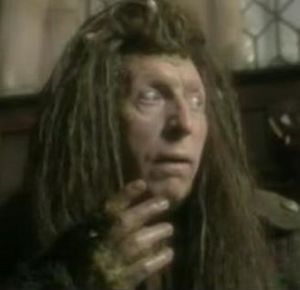Puddleglum facts for kids
Quick facts for kids Puddleglum |
|
|---|---|
| Narnia character | |

Tom Baker as Puddleglum in the BBC serial The Silver Chair
|
|
| Information | |
| Race | Marsh-wiggle |
| Nationality | Narnia |
Puddleglum is a fictional character in the popular children's fantasy series The Chronicles of Narnia by C. S. Lewis. He is a main character in the book The Silver Chair. Puddleglum is a "Marsh-wiggle," a unique creature invented by Lewis. He is the only Marsh-wiggle in the books who has a name and speaks.
Puddleglum is known for being quite gloomy and pessimistic. Other characters sometimes call him a "wet blanket." However, he says that other Marsh-wiggles are even gloomier than him! Lewis mentioned that his gardener, Fred Paxford, helped inspire the character of Puddleglum.
Contents
What's in a Name?
The name Puddleglum fits his character well. "Puddle" suggests his connection to water and wet places, like the marshes where Marsh-wiggles live. "Glum" perfectly describes his often sad or pessimistic view on life.
The name might come from an old translator named John Studley. Lewis once talked about Studley's funny word choices, including "Stygian puddle glum." "Stygian" refers to the River Styx, a famous river in ancient myths that flowed through the Underworld. This link is interesting because Puddleglum and his friends travel to the Narnian Underworld in The Silver Chair.
Puddleglum's Adventures
Puddleglum first appears in The Silver Chair when he joins Eustace and Jill. They are on a quest to find Prince Rilian, who disappeared ten years earlier. Puddleglum is a very strong and loyal friend, even though he often sees the bad side of things. He once said, "I see you're making the best of a bad job. That's right. You've been well brought up, you have."
At first, the children think he is a bit of a downer. But Puddleglum proves to be a brave and steady companion. This is especially true when they are in Underland. He often figures out the best plan. He is also the one who breaks the spell of the Lady of the Green Kirtle. He bravely stamps out her magical fire, even hurting his foot. This act frees Prince Rilian. The Lady then turns into a serpent, but Rilian defeats her. Puddleglum then helps Rilian and the children escape from Underland back to Narnia.
At the end of their journey, Jill gives Puddleglum a surprise hug and kiss. He is quite surprised and says, "Well, I wouldn't have dreamt of her doing that. Even though I am a good-looking chap." This shows a small, hopeful change in his usually gloomy outlook.
Puddleglum in Other Media
Puddleglum has been brought to life in different ways:
- In the 1990 television series by the BBC, Puddleglum was played by Tom Baker. Baker is famous for playing the 4th Doctor in Doctor Who.
- The voice of Puddleglum was provided by Ron Moody in the Focus on the Family Radio Theatre version of The Silver Chair.
- Bernard Cribbins voiced Puddleglum in the BBC Radio adaptation of the same story.
Puddleglum's Influence
Puddleglum has inspired other works:
- The Christian rock band The Swift used to be called Puddleglum.
- A character named Pugglemud appears in the children's book Kendra Kandlestar and the Box of Whispers by Lee Edward Födi. This name is a tribute to Puddleglum.
- American singer-songwriter Sarah Sparks sings "Puddleglum's Anthem" on her 2014 album "Into the Lantern Waste."
See also
 In Spanish: Charcosombrío para niños
In Spanish: Charcosombrío para niños

